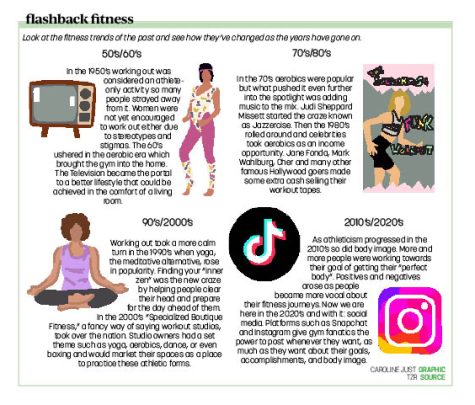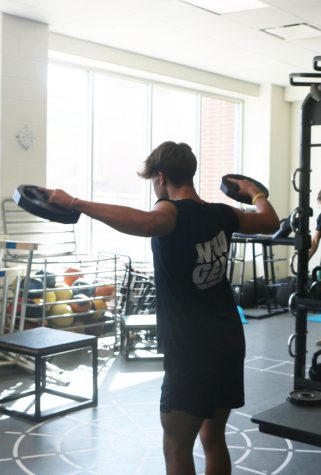From world-renowned Olympic athletes to just daily gym-goers, the gym has had a large presence in American culture. Wil Franks, gym-goer and junior, said he started going to the gym at 13 to better himself for his sports performance and it is now a hobby for him.
“It’s kind of like my outlet for everything. I go there if I am feeling happy, sad, mad; it’s just like my safe spot,” Franks said.
Similarly, sophomore Hudson Barry said he also began going to the gym at the age of 13 and has continued it through his high school career. Along with this, Barry said he has seen the gym give him more benefits than expected.
“I have definitely been able to sleep better when I go to bed just because I am tired. I’ve also grown in height and also muscle-wise,” Barry said.
Both Barry and Franks said they have noticed an influx of gym goers their age since the end of quarantine.

“I feel like during COVID, like after all the gyms shut down, I feel like people’s health went down and they just wanted to get back into it and be healthy again,” Barry said.
According to Trust for America’s Health, a nonpartisan organization that aims to promote health, the national obesity rate reached 42.4 % in the United States during 2020. Franks and Barry both said they believe the increase of gym memberships can be attributed to social media.
Along with this, Wellness teacher John Hebert comments that gym culture has stayed relatively the same, but has formed a new angle that has a big push on what your body looks like.
“The gym culture now is more geared to vanity, in my opinion,” Hebert said. “People are more focused on what they look like.”
Barry said he has also noticed a more vanity- centered approach to new gym-goers. He said he believes this is due to the influx of social media influencers who post about going to the gym and show younger children unhealthy ways to stay in shape.

“These kids in their younger years will go on a bulk and gain weight and then they’ll cut it,” he said, “you shouldn’t be cutting all that weight, especially in high school as a young kid, it’s just not healthy.” Barry said.
According to the National Eating Disorder Association (NEDA), one in three people who experience an eating disorder are male. The NEDA also states that many eating disorders in males stem from pressure to change physical appearance or pressure to conform to a societal perception of being “in-shape.”
Franks said, “A lot of younger kids have especially started going (to the gym). I think it’s because of social media, that puts a big influence on kids trying to look better, be bigger, and look like all these influencers.” he said.
Barry said influencers are the main cause of unhealthy habits in kids who start going to the gym.
“Especially the really big (influencers),” he said, “And like they just- they’ll make these youtube videos, and then they’ll start talking about dieting and cutting calories, but they’re also grown adults and they’re not in high school so it is safe for them to do that.” Barry said.
Franks said rather than worrying about looks, the gym culture should center around staying healthy and being in shape, along with watching yourself progress into a stronger individual.
“You go there, you work hard and you better yourself,” he said, “and it’s just about having a good environment and being the best version of yourself.”































![What happened to theater etiquette? [opinion]](https://hilite.org/wp-content/uploads/2025/04/Entertainment-Perspective-Cover-1200x471.jpg)













































![Review: “The Immortal Soul Salvage Yard:” A criminally underrated poetry collection [MUSE]](https://hilite.org/wp-content/uploads/2025/03/71cju6TvqmL._AC_UF10001000_QL80_.jpg)
![Review: "Dog Man" is Unapologetically Chaotic [MUSE]](https://hilite.org/wp-content/uploads/2025/03/dogman-1200x700.jpg)
![Review: "Ne Zha 2": The WeChat family reunion I didn’t know I needed [MUSE]](https://hilite.org/wp-content/uploads/2025/03/unnamed-4.png)
![Review in Print: Maripaz Villar brings a delightfully unique style to the world of WEBTOON [MUSE]](https://hilite.org/wp-content/uploads/2023/12/maripazcover-1200x960.jpg)
![Review: “The Sword of Kaigen” is a masterpiece [MUSE]](https://hilite.org/wp-content/uploads/2023/11/Screenshot-2023-11-26-201051.png)
![Review: Gateron Oil Kings, great linear switches, okay price [MUSE]](https://hilite.org/wp-content/uploads/2023/11/Screenshot-2023-11-26-200553.png)
![Review: “A Haunting in Venice” is a significant improvement from other Agatha Christie adaptations [MUSE]](https://hilite.org/wp-content/uploads/2023/11/e7ee2938a6d422669771bce6d8088521.jpg)
![Review: A Thanksgiving story from elementary school, still just as interesting [MUSE]](https://hilite.org/wp-content/uploads/2023/11/Screenshot-2023-11-26-195514-987x1200.png)
![Review: "When I Fly Towards You", cute, uplifting youth drama [MUSE]](https://hilite.org/wp-content/uploads/2023/09/When-I-Fly-Towards-You-Chinese-drama.png)
![Postcards from Muse: Hawaii Travel Diary [MUSE]](https://hilite.org/wp-content/uploads/2023/09/My-project-1-1200x1200.jpg)
![Review: "Ladybug & Cat Noir: The Movie," departure from original show [MUSE]](https://hilite.org/wp-content/uploads/2023/09/Ladybug__Cat_Noir_-_The_Movie_poster.jpg)
![Review in Print: "Hidden Love" is the cute, uplifting drama everyone needs [MUSE]](https://hilite.org/wp-content/uploads/2023/09/hiddenlovecover-e1693597208225-1030x1200.png)
![Review in Print: "Heartstopper" is the heartwarming queer romance we all need [MUSE]](https://hilite.org/wp-content/uploads/2023/08/museheartstoppercover-1200x654.png)


